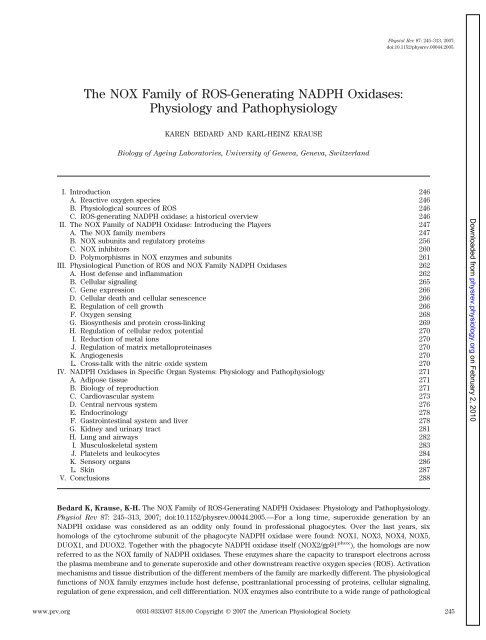Karen Bedard and Karl-Heinz Krause
Karen Bedard and Karl-Heinz Krause
Karen Bedard and Karl-Heinz Krause
Create successful ePaper yourself
Turn your PDF publications into a flip-book with our unique Google optimized e-Paper software.
The NOX Family of ROS-Generating NADPH Oxidases:<br />
Physiology <strong>and</strong> Pathophysiology<br />
KAREN BEDARD AND KARL-HEINZ KRAUSE<br />
Biology of Ageing Laboratories, University of Geneva, Geneva, Switzerl<strong>and</strong><br />
Physiol Rev 87: 245–313, 2007;<br />
doi:10.1152/physrev.00044.2005.<br />
I. Introduction 246<br />
A. Reactive oxygen species 246<br />
B. Physiological sources of ROS 246<br />
C. ROS-generating NADPH oxidase: a historical overview 246<br />
II. The NOX Family of NADPH Oxidase: Introducing the Players 247<br />
A. The NOX family members 247<br />
B. NOX subunits <strong>and</strong> regulatory proteins 256<br />
C. NOX inhibitors 260<br />
D. Polymorphisms in NOX enzymes <strong>and</strong> subunits 261<br />
III. Physiological Function of ROS <strong>and</strong> NOX Family NADPH Oxidases 262<br />
A. Host defense <strong>and</strong> inflammation 262<br />
B. Cellular signaling 265<br />
C. Gene expression 266<br />
D. Cellular death <strong>and</strong> cellular senescence 266<br />
E. Regulation of cell growth 266<br />
F. Oxygen sensing 268<br />
G. Biosynthesis <strong>and</strong> protein cross-linking 269<br />
H. Regulation of cellular redox potential 270<br />
I. Reduction of metal ions 270<br />
J. Regulation of matrix metalloproteinases 270<br />
K. Angiogenesis 270<br />
L. Cross-talk with the nitric oxide system 270<br />
IV. NADPH Oxidases in Specific Organ Systems: Physiology <strong>and</strong> Pathophysiology 271<br />
A. Adipose tissue 271<br />
B. Biology of reproduction 271<br />
C. Cardiovascular system 273<br />
D. Central nervous system 276<br />
E. Endocrinology 278<br />
F. Gastrointestinal system <strong>and</strong> liver 278<br />
G. Kidney <strong>and</strong> urinary tract 281<br />
H. Lung <strong>and</strong> airways 282<br />
I. Musculoskeletal system 283<br />
J. Platelets <strong>and</strong> leukocytes 284<br />
K. Sensory organs 286<br />
L. Skin 287<br />
V. Conclusions 288<br />
<strong>Bedard</strong> K, <strong>Krause</strong>, K-H. The NOX Family of ROS-Generating NADPH Oxidases: Physiology <strong>and</strong> Pathophysiology.<br />
Physiol Rev 87: 245–313, 2007; doi:10.1152/physrev.00044.2005.—For a long time, superoxide generation by an<br />
NADPH oxidase was considered as an oddity only found in professional phagocytes. Over the last years, six<br />
homologs of the cytochrome subunit of the phagocyte NADPH oxidase were found: NOX1, NOX3, NOX4, NOX5,<br />
DUOX1, <strong>and</strong> DUOX2. Together with the phagocyte NADPH oxidase itself (NOX2/gp91 phox ), the homologs are now<br />
referred to as the NOX family of NADPH oxidases. These enzymes share the capacity to transport electrons across<br />
the plasma membrane <strong>and</strong> to generate superoxide <strong>and</strong> other downstream reactive oxygen species (ROS). Activation<br />
mechanisms <strong>and</strong> tissue distribution of the different members of the family are markedly different. The physiological<br />
functions of NOX family enzymes include host defense, posttranlational processing of proteins, cellular signaling,<br />
regulation of gene expression, <strong>and</strong> cell differentiation. NOX enzymes also contribute to a wide range of pathological<br />
www.prv.org 0031-9333/07 $18.00 Copyright © 2007 the American Physiological Society<br />
245<br />
Downloaded from<br />
physrev.physiology.org on February 2, 2010













